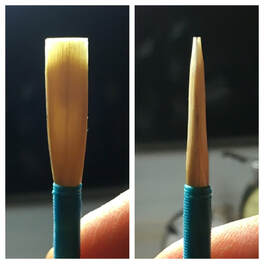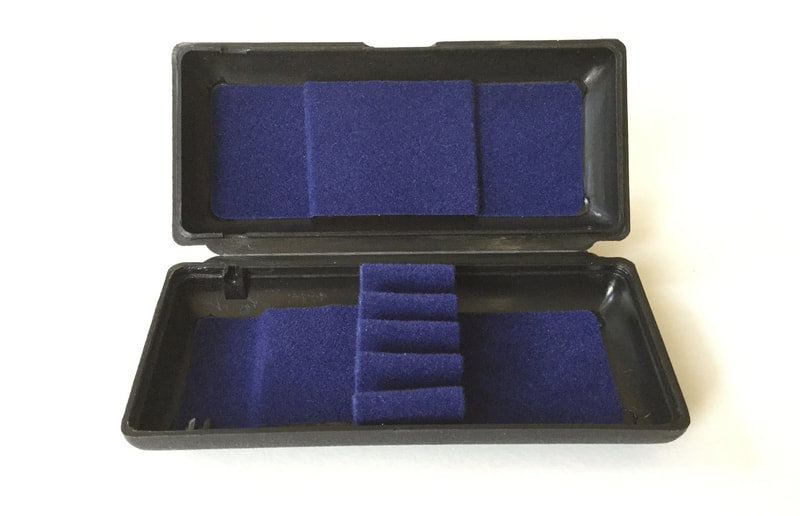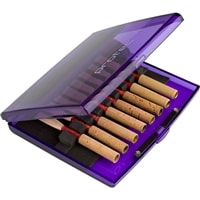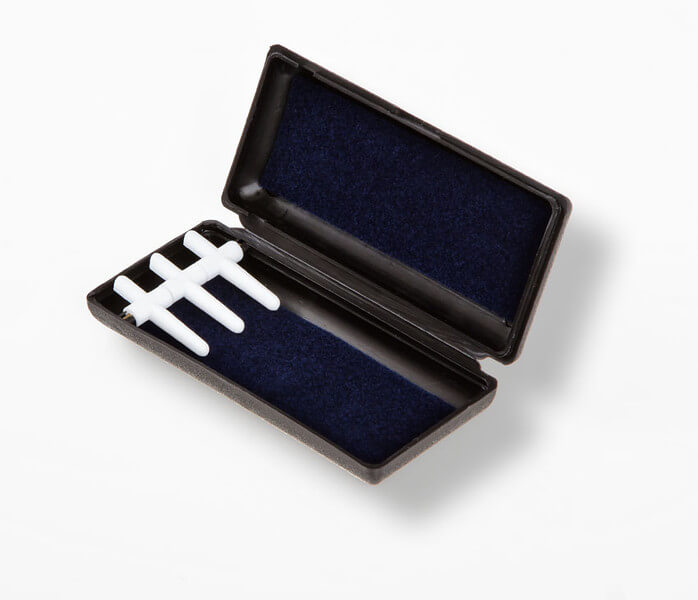Oboe Reed Basics
Dr. Lindabeth Binkley, Associate Professor of Oboe
Central Michigan University School of Music
Hand-scraped or Machine-made: What's the Difference?

While a young oboist's primary concern is always, "Where can I find a great reed?", it is equally important that they understand a bit about the construction of the reed, why it works the way it does, and the different things that can influence how a reed plays. In general, hand-scraped oboe reeds are preferred to machine-made oboe reeds. A hand-scraped oboe reed has been carefully made by an oboist to be responsive, play in tune, and have a beautiful sound when played. The reed has been tested and continuously adjusted by hand throughout the construction process. In general, machine-made reeds are made on a profiling machine and not tested for response, intonation, or tone quality before they are packaged and sold. If you are a new oboist, or the parent of one, a helpful introductory article about oboe reeds is written by Allison Baker, "The Selection and Care of Oboe Reeds," available on Banddirector.com. It does a great job of explaining the difference between machine-made and hand-scraped oboe reeds, how to store them, and how to take care of them. Dr. Sarah Hamilton, Oboe Professor at SUNY Fredonia School of Music, has written an excellent article, "Reed Help for Beginners," that details specific information designed to assist in the selection of an oboe reed. This includes what to look for in a reed without playing it, a method for testing reeds, and simple suggestions for fixing reeds. Dr. Hamilton also concisely explains the general problems with machine-made reeds. This article makes it clear why hand-scraped reeds are preferred to machine-made reeds. To give you the sense of how hand-scraped reeds can have different characteristics, read the blog post, "Oboe Reeds: Selecting the Best Reed For You," from Midwest Musical Imports. This post describes each of the hand-scraped reeds they have available for purchase as well as general information to help in the selection of an oboe reed. Hodge Products recently published this helpful blog post, "Oboe Reeds: Which Oboe Reed Should I Buy?." While it also pertains specifically to the reeds they sell, I greatly appreciate the list of Reed Characteristics, Tone Color terms, and chart of "Desirable" and "Undesirable" traits. I always prefer hand-scraped reeds over machine-made reeds, but it often takes a great deal of trial and error before you find a good fit. Frankly, it is the reason why oboists learn how to make their own reeds. When you make your own reed, you can control every aspect of your sound and how the reed feels when playing it. The Reed Case Is Important
Oboe reeds are expensive ($15-$30). They will last longer if stored in a proper reed case. An oboe reed case that holds the reeds tightly via french ribbon holders or a foam rubber grip holder is ideal (left and middle pic above). Avoid cases with what is known as pop-up mandrels (pic on the right) unless it has extra cushion to hold the reeds tightly on the mandrels when closed. If there is no extra cushion in these cases, the reeds will tend to slide off the mandrels and roll around freely in the case, causing reeds to chip and/or crack.
I recommend that beginners have an inexpensive reed case that holds a minimum of 3-4 reeds. (FYI: You can find reed cases that hold 3 to 50 reeds.) As an oboist advances, so will their tendency to collect reeds, which means they may eventually need a case that holds 5-10 reeds. There's also a wide variety of materials used to make reed cases, which can greatly influence their price. For many oboists, it's a very personal item. (Just google "oboe reed case" and look at the images. You will see what I mean!) Oboe reed cases can be found at many online retailers and places that sell oboe reeds. How many reeds does my oboist really need? How long will one last?
There is no way that I can tell you with utmost certainty how long a reed will last. They are delicate and the cane is scraped very thin in order for it to vibrate. For this reason, they are very fragile and susceptible to climate changes (humidity/dryness), altitude, and temperature. If you live in an area with different seasons, your oboist will feel the change of season in the way their reeds respond and play.
The number of times a reed is soaked and how long it is allowed to sit soaking in the water will also influence a reed's longevity. An oboe reed should never sit in water for more than 2-3 minutes at a time. Chronic over-soaking is the worst thing you can do to a reed! It "tires out" the fibers and they seem to wear down (lose vibration) more quickly. An oboe reed's fragility also makes it easy to damage (chipping of the tip, cracking, etc.). The best way to prolong the life of any reed is to make sure it is stored in a reed case in which the reed is held tightly and securely. So, considering all that, my recommendation for young oboists is this: start with at least 3-4 reeds. Write a number on the top part of the cork (near the thread) with a fine point Sharpie on each one. The oboist should then rotate through the reeds, changing each week (or every few days). If things go well, it is entirely possible that the three reeds could last 4-6 weeks, depending on how much they are played (and if they are cared for properly). However, if the oboist is seriously engaged (practicing 5-6 days a week for 30-60 minutes), they may tend to go through reeds more quickly. As the oboist's embouchure gets stronger and they they start playing for longer periods of time, they might need to increase their reed strength. For example, a typical Medium Soft strength is usually great for beginners, but as soon as they figure out how to truly support their sound, they may blow so much air that the Medium Soft reed just can't handle it. The reed will literally stop vibrating because they are blowing so much air it causes the tip of the reed to collapse. So, if you start hearing a lot of complaints about the sound suddenly stopping when they are playing, it might be time to try a harder reed strength. How soon can my oboist learn how to make their own reeds?
Short answer: When they have a stable embouchure, great air support, and excellent sense of intonation.
More complete answer: Most young oboists only learn how to make reeds if they are taking lessons with an oboist who can teach them the process. It is best to follow the advice of their oboe teacher, who will know when it is time for your oboist to start learning about reed making (usually when the items mentioned in the aforementioned short answer are well in hand). Reed making is a serious financial investment. The initial investment for tools, oboe cane, and other supplies will likely run between $130-$150. It is also a serious time commitment. In addition to practice time, the oboist will need to find time in their daily schedule to "practice" reed making. Regular tying, scraping, and crowing is critically important as they begin learning this skill. If your oboist is already involved in more that one or two extra curricular activities outside of playing the oboe, adding reed making to their activities may not be such a great idea. Most importantly, because oboe reed making is such a complicated process, parents need to understand that it usually takes many years before an oboist can actually make reeds on which they can play in public, particularly if they are not consistently working on their reed making skills . While they are learning, they will likely still need to buy reeds for their big performances. That being said, there are many opportunities for oboists to "dip their toe" in the reed making process if they do not have a private teacher. Things like the Oboe Reed Making Camp I teach at Central Michigan University, Bocal Majority Camps, and University of Wisconsin-Eau Claire Oboe Camp will all include some degree of reed making instruction. I highly recommend that if your oboist is asking about reed making, and they don't have a teacher, that they attend a summer program like one of these. They often provide a great introductory experience. |
Links for the Purchase of Oboe Reeds
DISCLAIMER: I am not paid to endorse any particular brand, reed maker, or seller. These suggestions are based only on my personal experience.
There are many variables at play when it comes to oboe reeds. Due to the nature of their construction, they can vary reed to reed even within the brand or reed maker. For example, a reed purchased in January may not be identical to a reed purchased in March. I look for overall consistency in construction and quality of materials when selecting reeds from a company or reed maker. Playing comfort is also dependent upon how the embouchure holds the reed and the amount of air support being used. What works for my playing setup and that of my students may not work for you, so please keep that in mind if you try one of these specific reeds. The HB Student Oboe Reed ($16) is an excellent choice for beginning/intermediate oboists who use a "round" or "straight-line" embouchure. If your oboist's embouchure tends to look like a "smile," this may not be a good reed choice for you. I also like the reed style and consistency offered by Rose Reeds. She offers a wide variety of reeds suitable for beginners through more advanced players. Intermediate to Advanced players may find success using the Jones Artist Oboe Reed (Medium or Medium Hard). I would not recommend the Medium Soft strength as it might be too easy. The Jones Artist Oboe Reed is a recent discovery that I am going to monitor over the next several months. I'd like to get a sense of their consistency, but at first glance, I really like what I see and hear from these reeds. Other excellent reed makers for Intermediate to Advanced players are: Obonik Oboe Duck Reeds Another option is to search for oboe reeds on etsy.com. You will find a wide variety of hand-scraped oboe reeds at various price points, strengths, and styles. It may take some trial and error to find a reed maker that you like, but you will be buying from an oboist and will be able to interact with them throughout the purchase process. Many will likely be able to customize the reeds for your oboist, too. Midwest Musical Imports and Hodge Products are stores that cater to oboists. They both stock a wide variety of reeds and have very helpful staff that could help guide you to a good reed for your oboist. Midwest Musical Imports Hodge Products |


